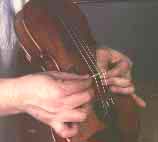Instrument Care...
 A
Few Guidelines A
Few Guidelines
Keep it safe
- Keep your instrument and bow in the case and in a safe
place when not in use. Remember not to leave pencils, shoulder
rests or anything else in the case that could damage the
instrument.
- Never put a violin or viola on a chair -- it
will get sat on!
- Be aware of shirt buttons, bracelets and dangling earrings
-- they are often the cause of scratches, dings and
dents.
- Handle your violin or viola carefully by the neck and chinrest to
prevent accidental damage and to avoid deterioration of the
varnish.
Keep it clean
- A clean instrument sounds better than one ingrained with
dirt and rosin dust. Wipe the strings and top of the instrument free of rosin
after each use, because over time it can build up and create
a sticky mess. Also, rosin is slightly acidic and can damage
the finish. A soft, dry cloth will do.
- If you clean consistently, it should not be necessary to
use a specialized bowed instrument polish or cleaner.
- Don't use
furniture polish or household cleaners -- they will either
leave a deposit on the instrument or rub the varnish away.
Keep its environment constant
- Protect your instrument from extreme heat or cold and from
sudden changes in temperature. Never leave it in a car!
Excessive heat softens the glue that holds your instrument
together, bubbles the varnish, and ruins some types of cases.
- Ideally, your instrument should be stored in 45-55% relative
humidity. If the air is too dry the wood will shrink, causing cracks.
During winter, if you don't have a home
humidifier, it's wise to buy a
Dampit instrument humidifier.
Keep an eye on the setup
- Never move or adjust the sound
post yourself. If you
suspect a problem with it, or if it falls over, immediately
loosen tension from the strings and take your instrument to
a trained technician.
(If you need to learn about bowed instrument parts, visit the
Beginners section)
- Inspect the bridge often to be sure it is in the correct position. It should tilt very slightly
backward toward the
tailpiece (the bridge is held in place only by the pressure
of the strings; it is not glued to the instrument.) Tuning
with the pegs tends to pull the bridge forward, which causes
the bridge to "warp." From time to time, you need to gently
grab both sides of the bridge at the top (closest to the
strings), and work it back ever so slightly until the lean
is visible. You must be very gentle in doing this so as not
to completely knock the bridge over. Always make sure both bridge feet are securely touching
the top of the instrument.
- When changing strings, never release the tension of more than one string at a
time, or the alignment of the bridge and sound post may get
out of place.
|
|

Wipe the rosin off your instrument after each use
|
|
|

How often should I change strings on my instrument?
Over time, strings lose their brilliance and
resonance and sound dull and lifeless. Many
musicians don't realize how the sound of their strings has changed
because the change is so gradual. So don't wait until they break
to change them!
-
Look for fraying at the nut, around the
bridge, tailpiece, or section of unwound strings.
-
Listen for a string going "false,"
that is, when bowed quickly across the open string,
the pitch wavers.
Replace strings depending on how often you play.
Some players change strings every few months, others, every year.
|
|
|
|

The bridge is supposed to be maintained at
a slightly backward lean toward the tailpiece
|